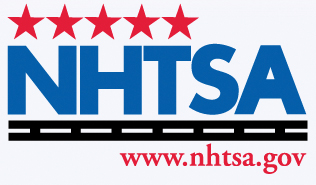 
SCHOOL BUS TRANSPORTATION
ILLEGAL PASSING:
The Problem
The big yellow school bus approaches the intersection of First and Main. Seven or eight elementary school students are waiting near the curb. First the yellow lights come on. Then the school bus comes to a halt. The red lights start to flash. The stop arm goes out. The school bus driver looks at the traffic behind her and in front of her and thinks, "Will anyone try to pass?" |
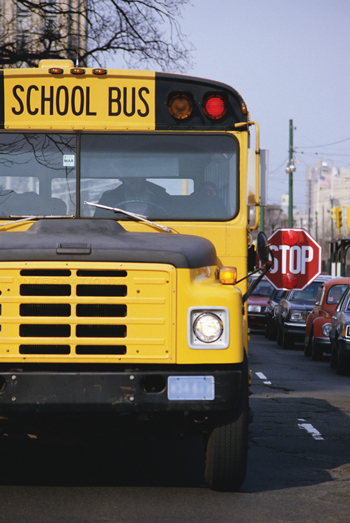 |
School buses and motorists. Both have been part of the morning and afternoon landscape for five generations of school children. Although yellow wasn't adopted as the school bus color until 1939, school buses have been around since 1915, about as long as the automobile.
In all that time there has been an uneasy coexistence between school buses and motorists. School buses make frequent stops to load and unload students. It is the nature of their business. By law, when a school bus stops to drop off or pick up students, motorists must stop too. But motorists often don't want to stop. Motorists want to get where they are going with little interruption and as quickly as they can.
The act of illegally passing a stopped school bus with red lights flashing is commonly known as a “stop-arm violation.” This refers to the stop-sign shaped “arm” that extends from the left side of the bus when the red lights are activated.
Yet, in a 1997 survey on speeding and other unsafe driving behaviors, 99 percent of the drivers interviewed felt that the most dangerous unsafe driving behavior was passing a school bus with its lights flashing and stop arm extended. Passing a stopped school bus was considered to be more dangerous than any other unsafe driving behavior, more dangerous even than racing another driver, driving through a stop sign or red light, crossing railroad tracks with red lights blinking, passing in a no passing zone, and speeding.
The National Survey of Speeding and Other Unsafe Driving Actions was commissioned by the NAtional Highway Traffic Safety Administration. Three thousand drivers, ages 16 to over 65, completed the unsafe driving survey. To get a copy of the three-volume report (DOT HS 808 749) describing the methodology, the findings, and suggested countermeasures contact the National Technical Information Service, Springfiled, VA 22161. (www.ntis.gov or call 703-605-6000).
It's The Law
Every one of the 50 states has a law making it illegal to pass a school bus with its red lights flashing and stop-arm extended that is stopped to load or unload students. However, some motorists simply choose to ignore the law.
- They might be coming toward the bus, decide that no students are crossing the road, and just keep going.
- They might be behind the bus, pull into the left lane, and go around the bus.
- They might be behind the bus, pull onto the shoulder, and pass the bus on the right.
All states require the traffic in both directions to stop on undivided highways when students are getting on or off a schoolbus. While wording varies from state to state, generally the law requires the following: The school bus driver activates flashing yellow lights to indicate the school bus is preparing to stop. The school bus driver activates flashing red lights and extends the stop arm to indicate the school bus has stopped and students are getting on or off. At this point, motorists should stop.
State law varies in what is required on a divided highway and what constitutes a divided highway. However, in all cases on divided highways, traffic behind the bus must stop.
Proving the Law Was Being Violated
While the number of actual crashes caused by this violation is low, the potential for injury or death is high. For years, school bus drivers have been aware of, and have complained about, motorists illegally passing their school buses. In the mid-1990's several states conducted surveys to determine the actual extent of illegal passing. What they found was worse than they had imagined.
- The School Transportation Management Section of the Florida Department of Education conducted a study in 1995 through the University of South Florida. On one day in May of that year, 10,590 vehicles illegally passed stopped school buses in 58 of Florida's 67 school districts. Since approximately 11,150 school buses participated in the survey, this meant an average of almost one illegal passing per school bus that day.
- A one day study was conducted in September 1996 in 119 of the 131 school divisions in the State of Virginia. On that day, 3,394 Virginia motorists illegally passed a stopped school bus. Multiplying the results by a 180 day school year brings the total number of illegal passings to over 600,000 a year. Of the 3,394 total in September 1996, 187 were right side passes, the side of the bus students use to enter and exit.
- In 1996, the Illinois Department of Transportation's Division of Traffic Safety conducted a probability based sample survey of 250 school buses to estimate the total number of stop-arm violations in the state. Drivers of 250 buses were asked to record stop-arm violations during a 41 school day time period. The survey was completed and returned by 135 drivers who reported 3,450 violations. Based on the findings, the estimated number of stop-arm violations each year in Illinois is over 1,900,000 making it a major traffic safety problem.
SCHOOL BUSES: FACTS

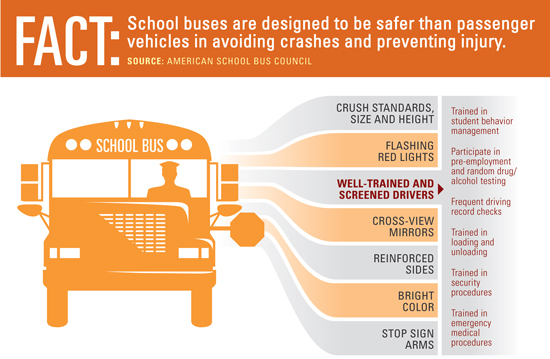
Today’s school buses are built with safety in mind. They are tougher, cleaner and more diligently maintained than ever before. School bus drivers are required to receive special security and medical training, and undergo regular drug and alcohol testing to provide a safe ride for your child. School bus traffic laws are strictly enforced. Find out what you don’t know about school bus ridership. Learn the facts and play it safe. Visit schoolbusfacts.com for more information.
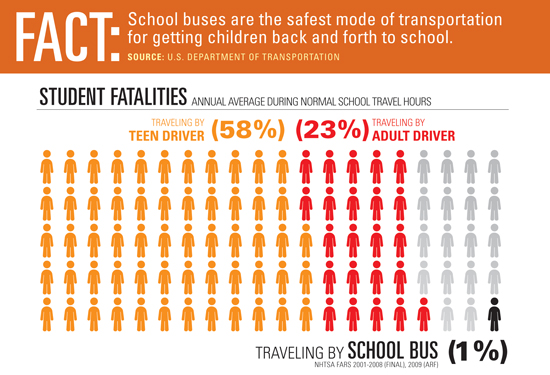
Students are about 50 times more likely to arrive at school alive if they take the bus than if they drive themselves or ride with friends. But did you also know that your child is much safer riding the bus than being driven by you? Add in the environmental and financial benefits, and it’s hard to find a reason to send your kids to school any other way. Find out what you don’t know about school bus ridership. Learn the facts and play it safe. Visit schoolbusfacts.com for more information.
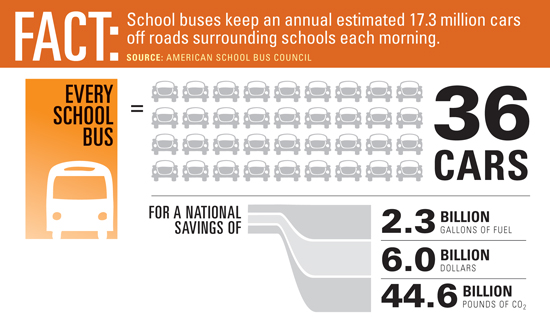
SEAT BELTS ON SCHOOL BUSES
The National Highway Traffic Safety Administration (NHTSA) establishes Federal motor vehicle safety standards to reduce the number of fatalities and injuries from motor vehicle crashes including crashes involving school buses.
NHTSA requires all new school buses to meet safety standards in addition to those that apply to all other passenger motor vehicles. These include requirements for improved emergency exits, roof structure, seating and fuel systems, and bus body joint integrity. NHTSA also works with each State on school bus safety and occupant protection programs. School bus safety is one of our highest priorities.
How safe are school buses compared to all other motor vehicles?
School buses are one of the safest forms of transportation in the United States. More than 42,000 people are killed in traffic crashes on U.S. roads every year. Every year, approximately 450,000 public school buses travel about 4.3 billion miles to transport 23.5 million children to and from school and school related activities. Yet, on average, every year, 6 school age children throughout the U.S. die in school bus crashes as passengers, a total of 11 as occupants of school transportation vehicles in general and 13 pedestrians. NHTSA strives to ensure that there are no fatalities in school buses.
We have seat belts in passenger cars. Why don’t we have them on school buses?
Seat belts have been required on passenger cars since 1968. Forty-nine States and the District of Columbia have enacted laws requiring the wearing of seat belts in passenger cars and light trucks. There is no question that seat belts play an important role in keeping occupants safe in theses vehicles, however, school buses are different by design and use a different kind of safety restraint system that works extremely well.
Child Safety Restraint Systems in School Buses are Designed to correctly secure preschool age children and to properly secure the system to a school bus seat.
An average of 24 school age children die in school transportation related traffic crashes each year, 11 occupants of school transportation vehicles and 13 pedestrians.
Steps for the designation of school bus stops and strategies to support safe pedestrian behavior by students between their homes and their bus stops are available to support a community’s particular needs.
Federal regulations do not prohibit the use of vans by schools, but require any van with a capacity of more than 10, sold or leased for use as a school bus, to meet the safety standards applicable to school buses.
USE OF NONCONFORMING VEHICLES FOR SCHOOL TRANSPORTATION
The National Highway Traffic Safety Administration is the agency responsible for establishing Federal motor vehicle safety standards (FMVSS) to reduce the number of fatalities and injuries that result from motor vehicle crashes.
In the legislative history of the School Bus Safety Amendments of 1974, Congress stated that school transportation should be held to the highest level of safety, since such transportation involves the Nation's most precious cargo - children - who represent our future. As a result, NHTSA believes that school buses should be as safe as possible. Accordingly, we have established minimum safety standards that are over and above those for regular buses that all school buses must meet. Consistent with the 1974 Congressional mandate for school bus safety, NHTSA believes that safety standards requiring higher levels of safety performance for school buses are appropriate.
Federal requirements regulate new vehicles that carry 11 or more persons that are sold for transporting students to or from school or school related events. Those vehicles are required to meet all FMVSSs for school buses.
The FMVSSs applicable to school buses require that school buses have stop arms along with many other safety features over and above those of other passenger vehicles.
Under 49 U.S.C. 30101, etseq., a vehicle is regarded as being sold for use as a school bus if, at the time of sale, it is evident that the vehicle is likely to be significantly used to transport students to or from school or school related events. This statute applies to school buses sold to public as well as parochial schools. Thus, a dealer selling a new 15 passenger van to be used for school transportation must ensure that the van is certified as meeting our school bus FMVSSs.
Federal regulations do not prohibit the use of vans by schools, but require any van with a capacity of more than 10, sold or leased for use as a school bus, to meet the safety standards applicable to school buses. Federal regulations apply only to the manufacture and sale/lease of new vehicles. Each State prescribes its own regulations that apply to the use of any vehicle that is used to transport students.
NHTSA recommends that all passengers be seated within the confines of the school bus seats while the bus is in motion.
THE NUMBER OF PERSONS THAT CAN SAFELY SIT ON A SCHOOL BUS SEAT
Federal regulation does not specify the number of persons that can sit on a school bus seat. The school bus manufacturers determine the maximum seating capacity of a school bus. The manufacturers use this number, which is based on sitting three small elementary school age persons per typical 39 inch school bus seat, in the calculations for determining the gross vehicle weight rating and the number of emergency exits.
School transportation providers generally determine the number of persons that they can safely fit into a school bus seat. Generally, they fit three smaller elementary school age persons or two adult high school age persons into a typical 39 inch school bus seat.
NHTSA recommends that all passengers be seated within the confines of the school bus seats while the bus is in motion. Federal motor vehicle safety standard No. 222, "School Bus Passenger Seating and Crash Protection" requires that the interior of large buses provide occupant protection so that children are protected without the need to buckle up.
Occupant crash protection is provided by a protective envelope consisting of strong, closely spaced seats that have energy absorbing seat backs. Persons not sitting or sitting partially outside of the school bus seats will not be afforded the occupant protection provided by the school bus seats.
SCHOOL TRANSPORTATION RELATED CRASHES
A school transportation related crash is a crash which involves, either directly or indirectly, a school bus body vehicle, or a non school bus functioning as a school bus, transporting children to or from school or school related activities.
Since 2000 there were 371,104 fatal motor vehicle traffic crashes. Of those, 1,245 (0.34%) were classified as school transportation related.
| Since 2000, 1,386 people have died in school transportation related crashes—an average of 139 fatalities per year. Occupants of school transportation vehicles accounted for 8 percent of the fatalities, and nonoccupants (pedestrians, bicyclists, etc.) accounted for 20 percent of the fatalities. Most of the people who lost their lives in these crashes (72%) were occupants of other vehicles involved. |
 |
An average of 19 schoolage occupants of school transportation vehicles (6) and pedestrians (13) die in school transportation related traffic crashes each year. |
Since 2000, 130 school age pedestrians (younger than 19) have died in school transportation related crashes. Over two-thirds (67%) were struck by school buses, 6 percent by vehicles functioning as school buses, and 27 percent by other vehicles involved in the crashes. There were 56 (43%) school age pedestrians killed in school transportation related crashes between the ages of 5 and 7.

On average, 10 school age pedestrians are killed by school transportation vehicles (school buses and non-school bus vehicles used as school buses) each year, and 4 are killed by other vehicles involved in school bus related crashes.
More school-age pedestrians have been killed between the hours of 3 p.m. and 4 p.m. than any other time of day.
Between 2000 and 2009, 85 crashes occurred in which at least one occupant of a school transportation vehicle died. More than half of those crashes (56%) involved at least one other vehicle. In the 37 single vehicle crashes, 43 occupants—16 drivers and 27 passengers—were killed. In the 48 multiple vehicle crashes, 26 drivers and 38 passengers died. In the 37 single vehicle crashes, the first harmful events were as
follows: striking a fixed object (22 crashes), a person falling from the vehicle (5 crashes), the vehicle overturning (5 crashes), the vehicle colliding with a train (1 crash), other non collision (1 crash), and collision with a non fixed object (1 crash).
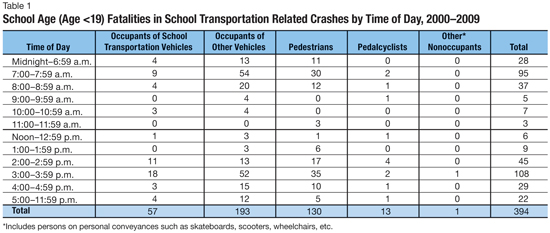
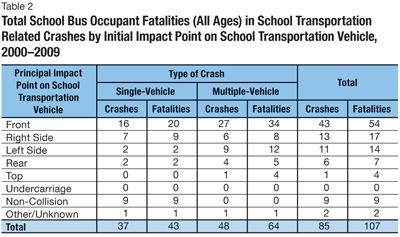 |
From 2000 to 2009, 56 (43%) school age pedestrians killed in school transportation related crashes were between 5 and 7 years old. |
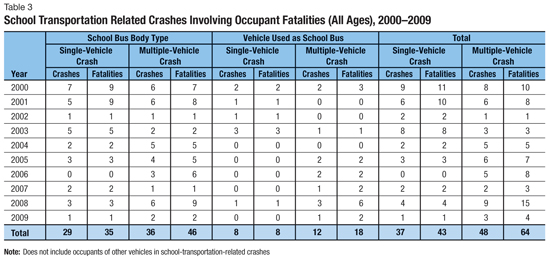
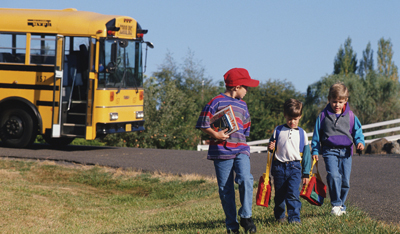
Impacts to the front of the school transportation vehicle occurred in 51 percent of fatal school transportation related crashes.
From 2000 to 2009, nearly three-fourths (73%) of the school age pedestrians fatally injured in crashes were struck by a school bus or a vehicle functioning as a school bus, while 27 percent were struck by a vehicle of another body type. One-third (34%) of school age pedestrians fatally injured in school transportation-related crashes were struck by a school bus or a vehicle functioning as a school bus that was going straight.
Since 2000, three drivers and one passenger have died in school bus body vehicles providing transportation for purposes other than school or school related activities (churches, civic organizations, etc.).
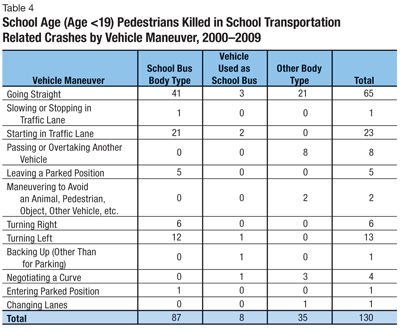

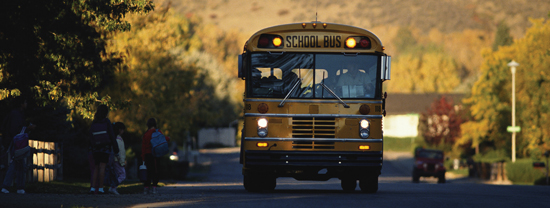
SELECTING SCHOOL BUS STOP LOCATIONS
The following factors influence student safety around traffic between home and the school bus stop and should be considered during the bus stop placement process.
Many school districts or states have policies that specify the maximum distance permitted between a student’s home and the school bus stop. The distance between home and the stop:
- Typically ranges from one to one and one-half miles;
- Sometimes varies with the age of the rider;
- Are increasing in some districts due to economic constraints that are impacting bus service;
- Assumes that parents will ensure the child’s safety between the home and school bus stop;
- May be determined from the center of the roadway outside of the residence to the bus stop, not from the front door of the residence to the stop;
- Is usually approved by the school board and follows state guidelines;
- May be determined by examining safety issues on a case by case basis instead of using a certain distance standard;
- School bus stops should be located so that students and parents have adequate pathways to walk from home.
Although it may not always be possible to provide all these features, desirable pedestrian routes:
- Minimize or avoid street crossings;
- Have traffic controls (stop signs or traffic signals) to provide assistance to pedestrians if crossing streets cannot be avoided;
- Have sufficient space to walk that is separated from traffic, ideally, a sidewalk or path separated from the roadway is available;
- Do not require walking on high volume, high speed roads;
- Are passable in snowy weather.
Several resources are available for transportation professionals and parents to use to assess how “walkable” a particular route is from one location to another. The “Walkability Checklist” available from the Pedestrian and Bicycle Information Center gives insight into the walkability of a neighborhood by raising questions such as:
• Did you have room to walk? Potential problems include:
1. Sidewalks or paths started and stopped;
2. Sidewalks were broken or cracked;
3. Sidewalks were blocked with poles, signs, shrubbery, dumpsters, etc.;
4. No sidewalks, paths, or shoulders.
• Was it easy to cross streets? Potential problems include:
1. Road was too wide;
2. Traffic signals made us wait too long or did not give us enough time to cross;
3. Street needed striped crosswalks or traffic signals;
4. Parked cars blocked our view of traffic;
5. Trees or plants blocked our view of traffic;
6. Sidewalks needed curb ramps or ramps needed repair.
• Can a child:
1. Cross at crosswalks or at a location where the child can see and be seen by drivers;
2. Stop and look left, right and then left again before crossing street;
3. Walk on sidewalks or shoulders facing traffic where there are no sidewalks;
4. Cross with the traffic signal.
An additional benefit of using a walkability checklist is that it can serve to document and demonstrate the need for pedestrian facilities or improvements to existing facilities when approaching traffic engineers or planners about these issues.

© 2013 TLC Magazine Online, Inc. |